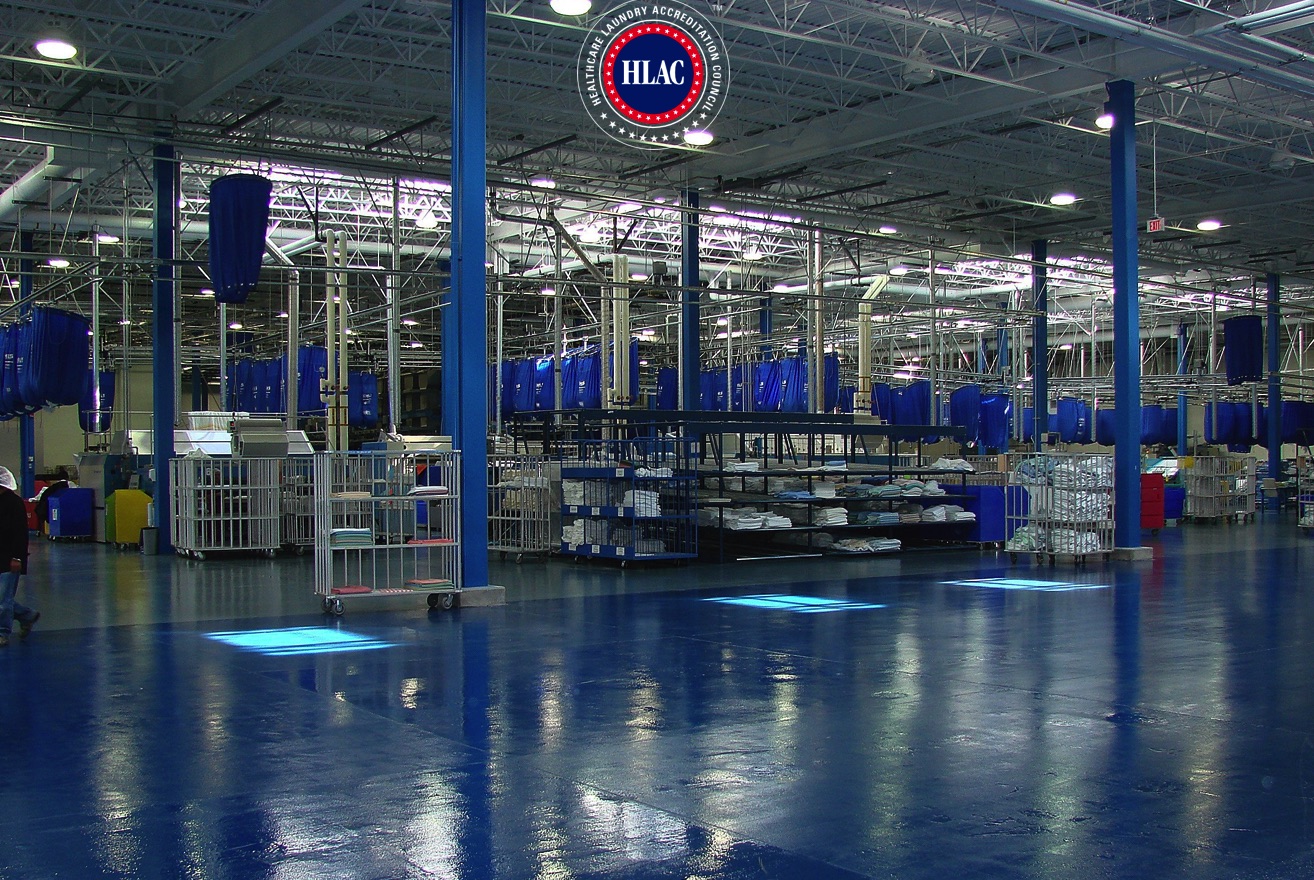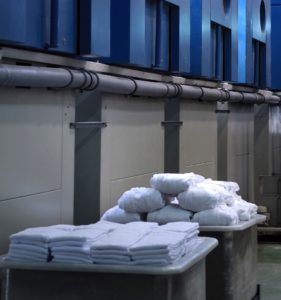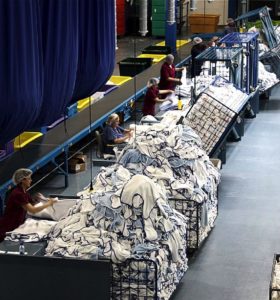
Note: This is one of a four-article series originally published in Infection Control Today and sponsored by the Healthcare Laundry Accreditation Council (HLAC). Reprinted with permission of HLAC. Links to all articles can be found below.
By Gregory Gicewicz, John Scherberger and Lynne Sehulster, PhD
An effective healthcare laundry solution, like having hospital textiles processed by a laundry accredited by the Healthcare Laundry Accreditation Council (HLAC)*, aligns perfectly with the objectives of most healthcare C-suites. The trick is communicating this alignment in the language of the C-suite.
The observant, well-informed and articulate infection preventionist (IP), and possibly the facility’s environmental services (EVS) director, can be the most important messengers in this critical communication. In all likelihood, these are the individuals who have recognized that healthcare textiles (HCTs) are the one common factor of virtually every patient’s experience in a hospital, long-term facility or other healthcare venue.
The “take-home” messages from the first three articles (links below) in this series on healthcare laundry can be helpful for framing the C-suite discussion points. The first of these articles made the case for selecting an HLAC-accredited laundry.1 HLAC emphasizes the routine monitoring of the laundry process, proper maintenance of the equipment, safety for the workforce, and best practice in all aspects of the production. HLAC encourages communication between the client facility and the senior laundry management and supervisors. Furthermore, monitoring of the laundry process is done in real time, so processing problems can be detected quickly and steps taken to prevent the affected load of HCTs from leaving the plant.
The second article in the series addressed the potential problem of clean HCTs becoming contaminated prior to use in a clinical setting.2 The point to be emphasized to C-suite  members is that the multidisciplinary team members of the healthcare facility will work in cooperation with the laundry to help prevent such contamination from occurring, thereby maintaining HCT cleanliness quality during transportation and storage. IPs can also decide if sterilization of HCTs directed to severely at-risk patient care is appropriate and add this to facility policies and procedures.3
members is that the multidisciplinary team members of the healthcare facility will work in cooperation with the laundry to help prevent such contamination from occurring, thereby maintaining HCT cleanliness quality during transportation and storage. IPs can also decide if sterilization of HCTs directed to severely at-risk patient care is appropriate and add this to facility policies and procedures.3
The business case for partnering with an HLAC-accredited laundry was presented in the third article, showing how an effective linen strategy can affect a healthcare facility’s bottom line.4 Advances in laundry processes, laundry chemistries, built environmental designs and environmental stewardship all contribute to reduced costs without compromising the organization’s quality of care.
From our experience gained from interacting with C-suite members, we have observed that the hospital C-suite’s key focus areas typically revolve around the following:
Ensuring patient safety Promoting patient satisfaction
Maintaining financial health and stability Compliance
Strategic planning and innovation Environmental stewardship.
With that in mind, we offer some key messages on these areas.
Ensuring Patient Safety
All hospitals must deal with the reality of healthcare-associated infections (HAIs), a situation that has reached epidemic proportions.5
The No. 1 goal in their HAI prevention campaign is the reduction of harm and loss of life. Be that as it may, commenting on HAIs, one hospital CEO noted: “A patient acquiring an infection as a consequence of participating in necessary healthcare is a failure of the system and/or the individuals within it.”6
In this regard, it’s important to make the point that patients have the most contact with HCTs during their care compared to contact with any other surfaces in the hospital, and this can have an impact on the quality of patient care.
HLAC accreditation standards are patient-safety focused, and reusable HCTs laundered in an HLAC-accredited laundry meet the definition of “hygienically clean” in accordance with both the recommendations from the Centers for Disease Control and Prevention (CDC) and the standards from the Association for the Advancement of Medical Instrumentation (AAMI).7-8
HLAC standards are nationally recognized and have been developed based on federal regulations, guidelines and industry best practices. And as discussed in the second article of this series, the laundry process is a robust antimicrobial process that prevents patient-to-patient transmission of pathogens from clean HCTs.2
Promoting Patient Satisfaction
This aspect of healthcare laundry may be something members of the C-suite may not have considered in the past. Given the frequency of patient skin contact with HCTs, a comfortable, aesthetically pleasing hygienically clean HCT — be it a patient gown, a bath towel, a bedspread, a fitted sheet, or an incontinence pad — will have a considerable impact on a patient’s satisfaction.
While higher-end HCTs may be more expensive at initial purchase, their positive impact on patient satisfaction can make this extra cost worthwhile. Furthermore, HCTs consist of a wide variety of fibers and fiber blends (e.g., cotton/polyester, nylon and other specialty fibers/fabrics. Today’s leading healthcare laundries can custom-tailor their laundering processes to reprocess these modern fabrics and textile items to fabric manufacturer instructions, thereby ensuring textile performance and aesthetic/sensory qualities.
Maintaining Financial Health and Stability
Where the COO is singularly focused on reducing the overall cost of “doing the hospital laundry,” the IP can help her or him – and the entire C-suite for that matter – to distinguish the connection between effective laundry strategy and reduced costs without compromising the organization’s quality of care.
This includes the decisions made about:

Linen choice — the different costs involved in the processing of synthetic, cotton or blended textiles
Low temperature chemicals — whose use saves money on heat used by the laundry and also saves on linen life
Disposable vs. reusable — disposables are costlier, they’re a biohazard waste, they can pose dangers to the healthcare environments
Linen care — hospital linen-care practices have a large impact on linen and laundry costs, and the IP nurse can play a significant role in raising awareness of this
Linen management — healthcare linen needs to be managed statistically, just like other consumable medical supplies. The consistent use of linen management software will facilitate data driven decisions about department par levels quantities rather than those made on nursing perceptions of usage.
Compliance
The C-suite of any hospital is concerned with compliance. An HLAC-accredited laundry will ensure that all laundry operations are in compliance with federal, state, funding, and city regulations, certifications, and licensing requirements. These include but are not limited to:
• Adhering to the OSHA Bloodborne Pathogen standard and other relevant OSHA standards for hazard identification and worker safety
• Complying with state/city water discharge laws
• Validating the wash process and results on a regular schedule
• Ensuring all laundry equipment is in good working order and operated only by licensed technicians where appropriate
• Ensuring the integrity and protection of all clean HCTs from plant to hospital
• Maintaining regular plant cleaning schedule.
Another point to mention about a laundry being HLAC-accredited is the fact that the laundry is familiar with necessary measures to comply with an inspection process and will be ready for inspections from either the hospital personnel or third party survey teams.
Strategic Planning and Innovation
The modern healthcare laundry industry abounds with strategic innovations that can align with a hospital’s strategic innovations. IPs can provide C-suite members with some examples of these innovations to heighten awareness of laundry contractors’ efforts to enhance their attention to infection prevention measures and effective linen management strategies. Such innovations can include:
• UV-treated rinse water as a means of enhancing infection prevention
• Using ATP monitoring devices to measure a laundry’s environmental cleaning processes
• Antimicrobial HCT including scrubs, flat goods, cubicle curtains, patient gowns, and EVS cleaning goods
• Air sampling of laundries to detect microorganisms and measure environmental cleaning
• Bacteriostatic laundry softeners
• Technologies using radio frequency identification (RFID) and bar code tracking can help to determine remaining use life for key HCTs
• Linen management software systems to track key metrics such as utilization by department, pounds per adjusted patient day, clean/soil ratios, linen losses, performance versus national standards, and fill rates
• RFID tracking systems to track locations, inventory, last processing dates and losses of key high expense items such as scrubs, cubicle curtains, OR textiles, lab coats and patient lifter slings
Environmental Stewardship
Most HLAC-accredited healthcare laundries are trend-setting leaders when it comes to “Green” practices and sustainability. These directly align with a hospital’s objective of environmental stewardship. Key areas where HLAC-accredited healthcare laundries lead in environmental stewardship include:
Pushing reusable textiles — Whether it is in the operating room, on the patient’s bed, or on the patient’s body, reusable HCTs are better for the environment, more comfortable, and support local jobs versus single-use disposable HCTs that fill up landfills and pollute our planet.
Water savings — A home washer consumes more than three gallons of water per pound of linen processed. A modern HLAC-accredited healthcare laundry consumes less than 0.8 gallons of water per pound of linen processed.
Plastic recycling — Most HLAC accredited healthcare laundries have programs to recycle used plastics from cart covers and linen bags rather than dispose of them into landfills.
Synthetic textiles — Many HLAC accredited healthcare laundries have switched to using synthetic HCTs in increasing numbers. These textile items dry much faster, thereby consuming fewer BTUs during processing. Furthermore, they typically last for more processing turns before having to be replaced.
High-efficiency continuous batch washers — Many HLAC-accredited healthcare laundries utilize ultra-high efficiency continuous batch washers. These environmentally friendly washers efficiently reuse water, heat, and chemistry thus greatly reducing the laundry’s environmental footprint.
We know that HAIs are a primary concern for virtually all hospital C-suites, with pay-for- performance mandates and the crackdown on reimbursements for related complications. This has cleared the path for the IP to begin making what ICT editor Kelly M. Pyrek has called a “solid business case for infection prevention and control at his or her healthcare institution.” In her article, “Making the Business Csae forInfection Prevention,” Prek called constructing a solid business case “one of the most critical skills an IP can have” and she provided key aspects necessary for making the case. Pyrek elaborated on the topic earlier this year in the first of her “IP/Stakeholder Series: The C-Suite,” in which she shared insights from industry professionals on how to foster communication and collaboration between IPs and key stakeholders.10
Is there room for the aforementioned laundry/linen messages in a business case for infection prevention, or for that matter in any other opportunity to communicate with the C-suite? We think so. And we strongly believe HLAC accreditation is an effective solution to have in hand in these communications.
About the Authors
Gregory Gicewicz is past president of HLAC and owner/operator of the healthcare laundry Sterile Surgical Systems in Tumwater, Wash.
John Scherberger is past president of HLAC.
Lynne Sehulster, PhD, recently retired from CDC after 20 years of serving as the Division of Healthcare Quality Promotion’s subject matter expert on environmental infection control.
Note: This four-article series was originally published in Infection Control Today and sponsored by the Healthcare Laundry Accreditation Council (HLAC). Reprinted with permission of HLAC. Links to all articles are below.
Article 1: Navigating the Intersection Where Healthcare Laundry and Infection Prevention Meet
Article 2: The Importance of Maintaining Quality of Laundered HCTs Prior to Use
Article 3: How IPs Affect a Hospital’s Bottom-Line with Effective Linen Strategy
Article 4: Aligning the IP’s Linen/Laundry Message with the C-Suite Mindset: Key Messages for a Key Messenger
==========================================
References:
1. Scherberger J. Navigating the intersection where healthcare laundry and infection prevention meet. Infect Control Today, Sept. 5, 2017.
2. Sehulster LM. Diligence in infection prevention is key to maintaining the quality of healthcare textiles. Infect Control Today, Oct. 6, 2017.
3. Duffy J, Harris J, Gade L, et al. Mucormycosis outbreak associated with hospital linens. Ped Infect Dis J 2014; 33: 472-476.
4. Gicewicz G, Larson JC. How IP nurses can affect a hospital’s bottom line with effective linen strategy. Infect Control Today, Nov. 6, 2017.
5. Centers for Disease Control and Prevention. Healthcare associated infections. Available at: https://www.cdc.gov/HAI/
6. Way A. A CEO’s View of Infection Prevention and Control. 2016.
7. Centers for Disease Control and Prevention and the Healthcare Infection Control Practices Advisory Committee (HICPAC). Guidelines for environmental infection control in healthcare facilities. Published 2003. Available at: https://www.cdc.gov/ infectioncontrol/pdf/guidelines/environmental-guidelines.pdf .
8. American National Standards Institute (ANSI) / Association for the Advancement of Medical Instrumentation (AAMI). ANSI/AAMI ST 65: 2009 R 2013 Processing of Reusable Surgical Textiles for Use in Health Care Facilities. Association for the Advancement of Medical Instrumentation: 2009.
9. Pyrek KM. Making the Business Case for Infection Prevention. Infection Control Today. Feb. 7, 2011.
10. Pyrek KM. IP/Stakeholder Series: The C-Suite. Infection Control Today. Jan. 30, 2017
*HLAC (Healthcare Laundry Accreditation Council) is a nonprofit organization formed for the purpose of inspecting and accrediting laundries processing healthcare textiles for hospitals, nursing homes and other healthcare facilities.













